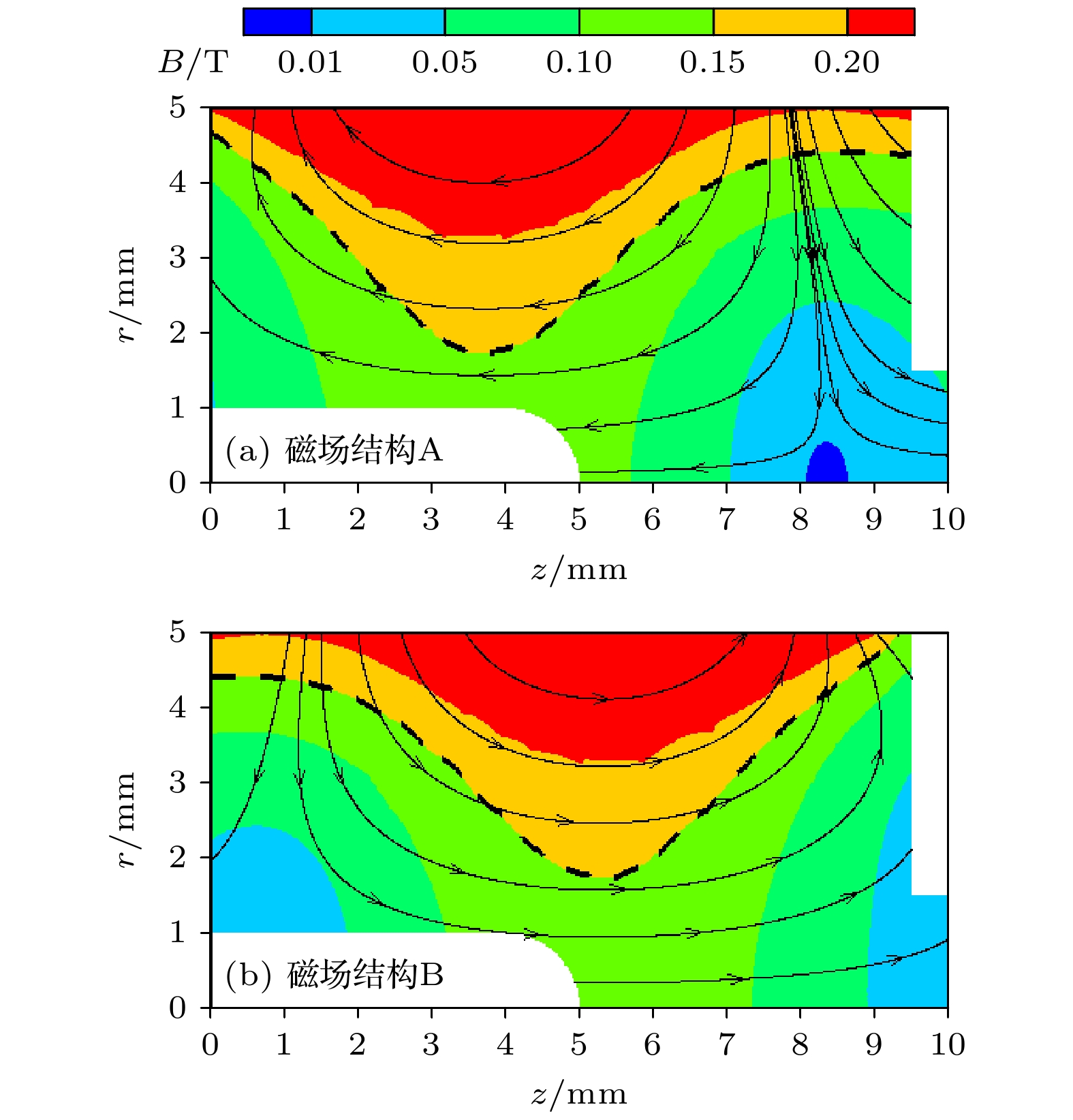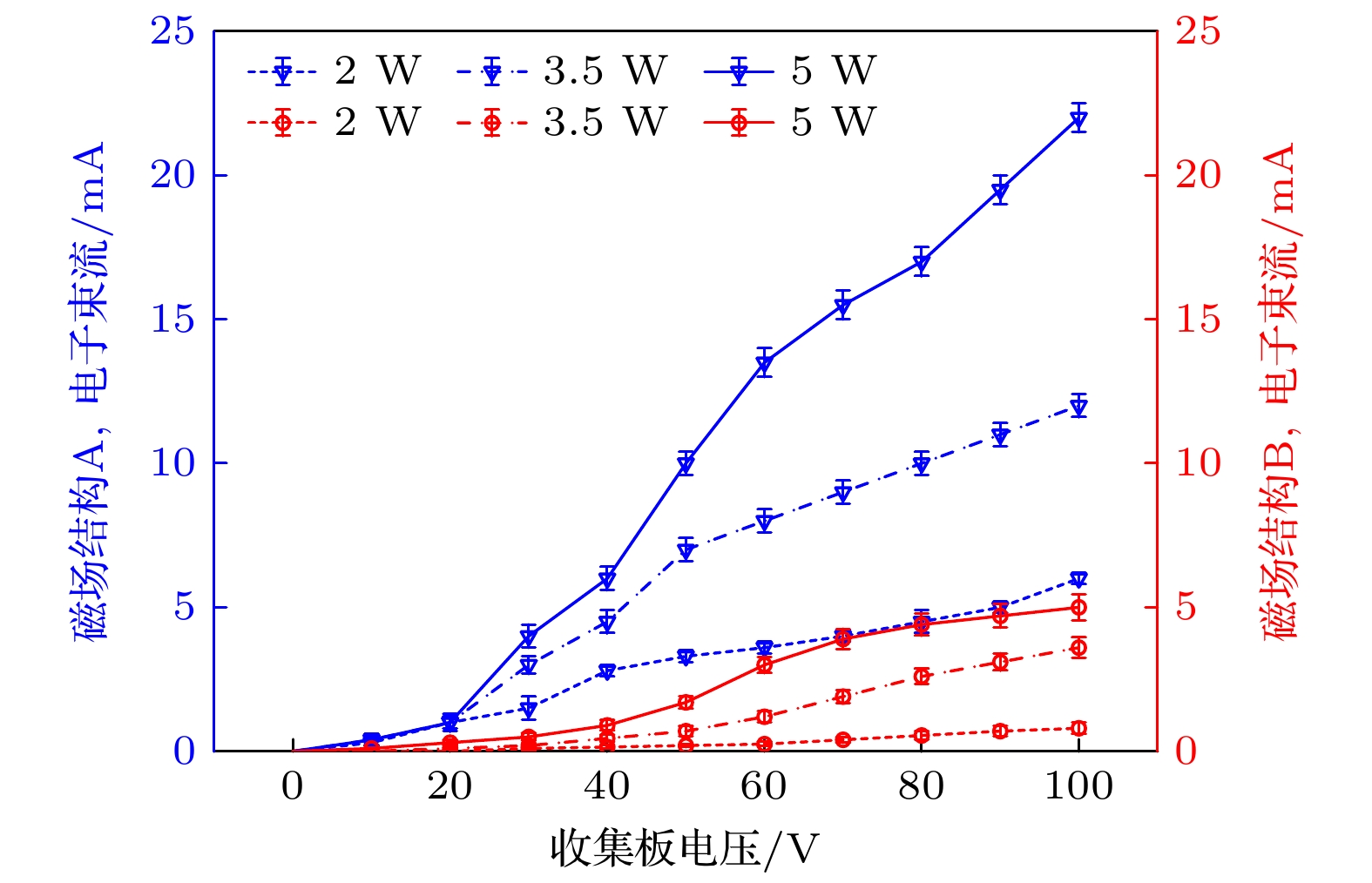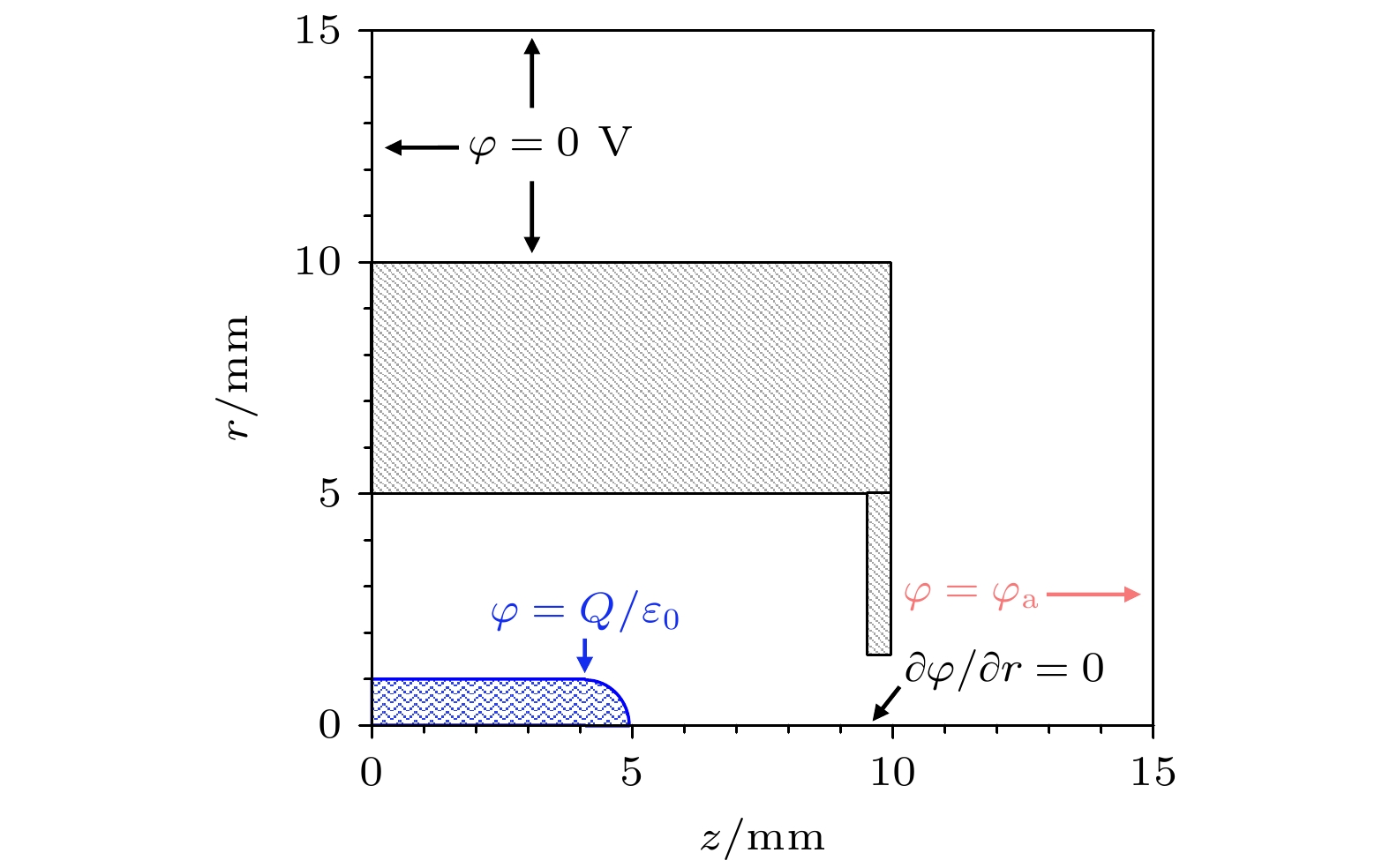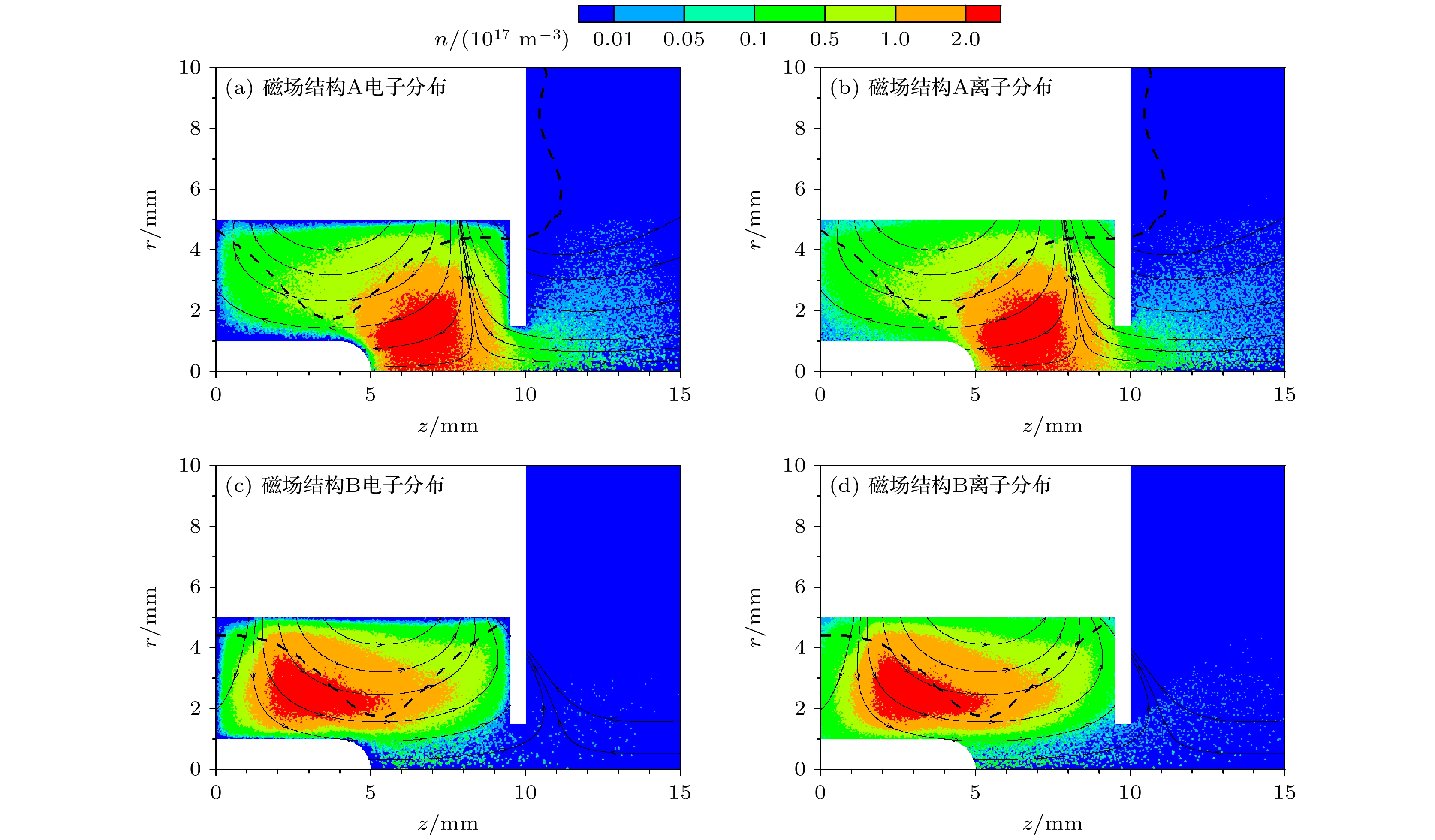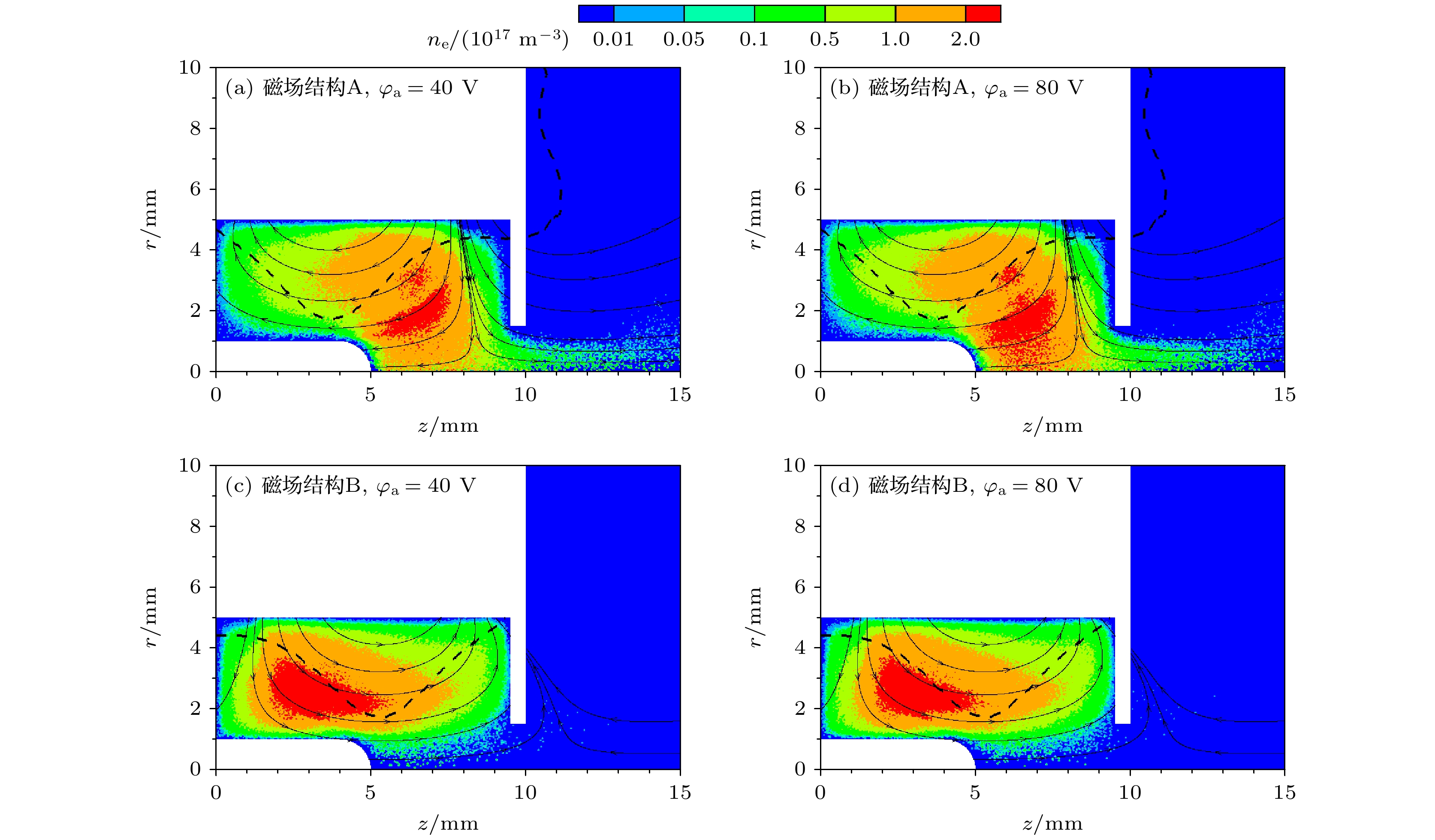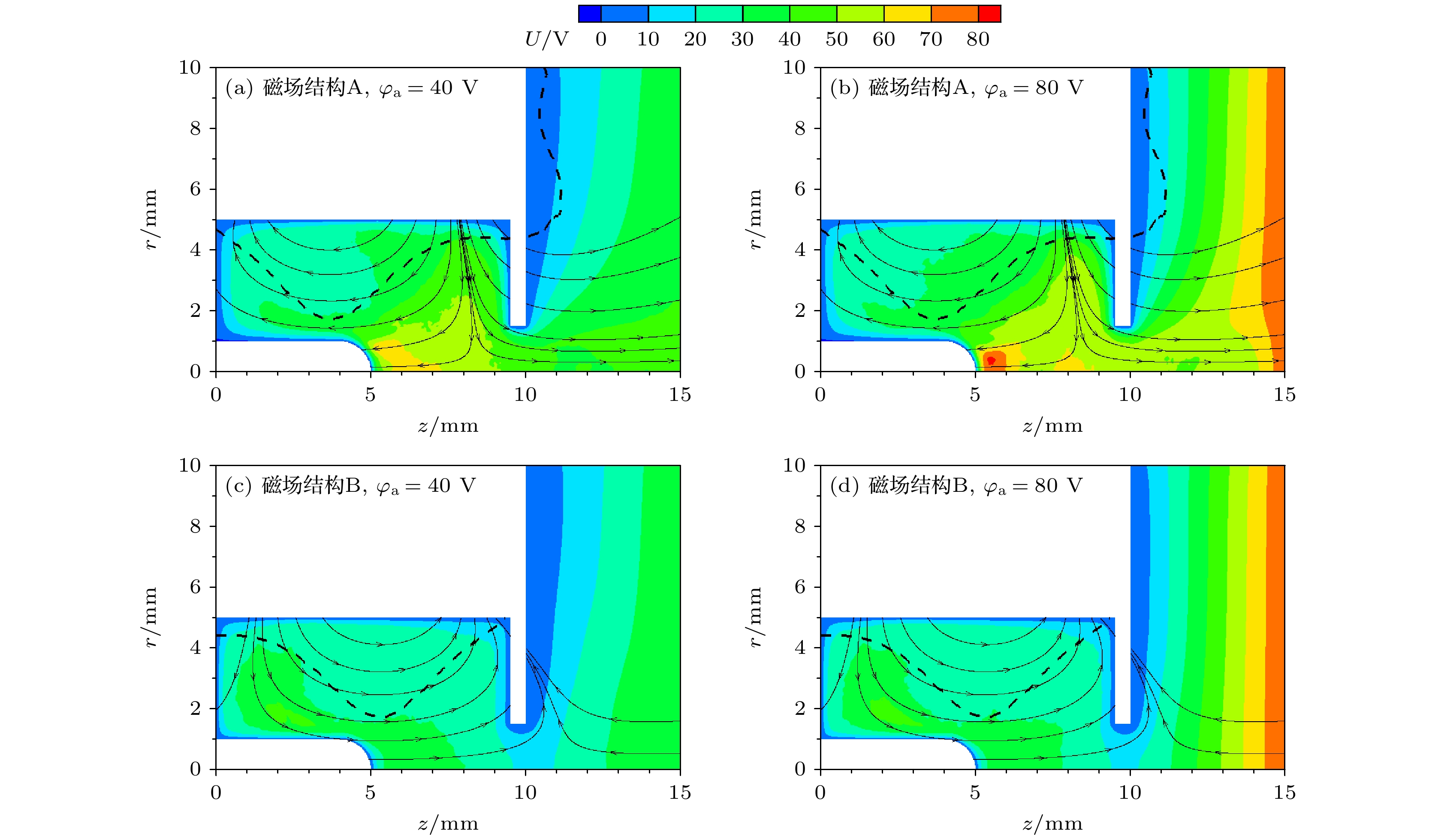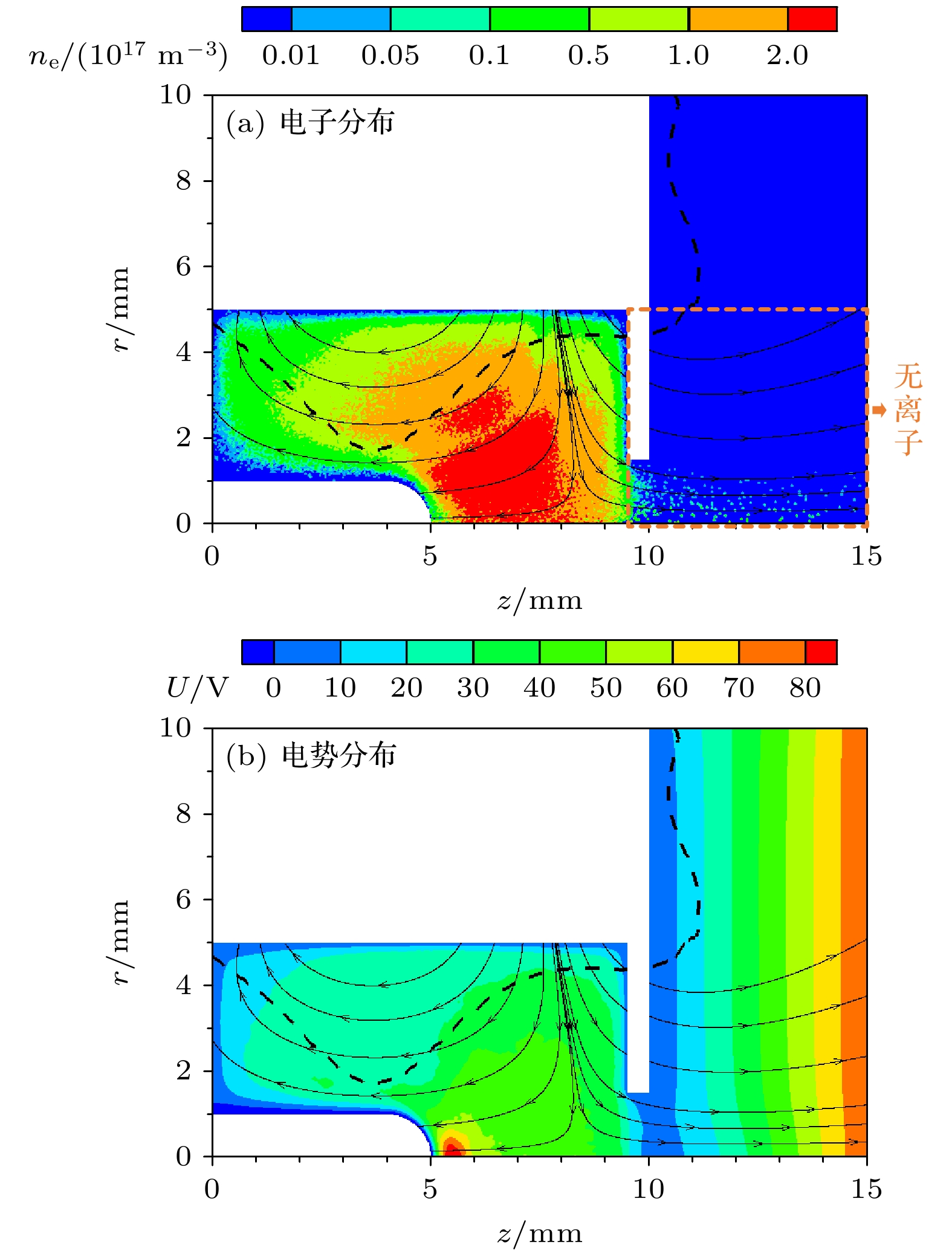-
微波放电中和器作为微波离子推力器系统的重要组成部分, 在维持航天器电位平衡、中和羽流方面发挥着重要作用, 其电子引出性能直接关系到电推力器系统的工作状态. 在磁阵列微波放电中和器的磁场结构定型实验中, 发现调转磁阵列朝向后引出电流的伏安特性曲线差异极大. 由于磁阵列微波放电中和器的放电室直径仅10 mm, 介入式探针诊断对等离子体干扰大, 本文采用了一体化粒子模拟方法对中和器的工作过程进行仿真, 仿真结果与实验现象相符合. 通过对比不同磁场结构、工作电压下的等离子体参数分布, 发现引出孔附近的电势分布决定着中和器的电子引出能力; 并进一步揭示了离子在中和器电子引出过程中发挥的关键作用, 阐明了磁场结构对中和器电子引出能力的影响机制. 最后, 本文总结了微波放电中和器有效引出电子的两个必要条件: 1)磁场梯度指向引出孔, 引导等离子体迁移; 2)引出孔附近有足够的离子抬升电势, 降低或打破电势阱.Microwave discharge neutralizer is an important part of microwave discharge ion thruster system, which plays a vital role in maintaining potential balance between spacecraft and neutralizing ion beam. Its electron extraction property directly affects the operation condition of ion thruster system. In order to break through the power limit of miniature microwave discharge ion thruster, a magnet array microwave discharge ion thruster system is designed and tested. In the experiment on finalizing magnetic field structure of magnet array microwave discharge neutralizer, an interesting phenomenon is found that the I-V curves of electron current, after rotating the magnetic array orientation, are very different. Defining forward direction of magnet array can normally extract electrons, then backward direction of magnet array can hardly extract electrons. Because the diameter of discharge chamber is only 10 mm, it is too small to perform Langmuir probe diagnosis. And thus, an integrative particle-in-cell method is used to simulate the neutralizer operation processes of two different magnetic field structures, and for the sake of accuracy, real vacuum permittivity is used. The simulation results show good consistence with experimental phenomenon. In the initial discharge process, it is found that the magnetic field gradient leads to different plasma distributions; in electron extraction process, it is found that the potential distribution near the orifice determines the electron extraction property of the neutralizer. Through comparing the plasma parameter distributions under different magnetic field structures and operating voltages, an assumption that the ion is an important factor in electron extraction process is proposed. Then, a simulation that ions disappear artificially outside the orifice is conducted, and the simulation results show that electrons cannot be effectively extracted without ions near the orifice. According to the simulation and experiment results, two necessary conditions are summarized for electron extraction of the neutralizer. The first condition is magnetic field structure: the magnetic field gradient should point towards the orifice to guide plasma migration towards the orifice, the second one is potential distribution: there should be enough ions to lift the potential near the orifice for reducing or breaking the potential well. These two conditions can help understand the electron extraction mechanism of microwave discharge neutralizer and provide theoretical reference for optimizing the performance of neutralizer in future.
-
Keywords:
- electron cyclotron resonance /
- neutralizer /
- electron extraction
[1] Nono A, Morishita T, Hosoda S, Tsukizaki R, Nishiyama K 2023 Acta Astronaut. 212 130
 Google Scholar
Google Scholar
[2] 杨涓, 牟浩, 耿海, 吴先明 2023 推进技术 44 2208095
Yang J, Mou H, Geng H, Wu X M 2023 J. Propuls. Tech. 44 2208095
[3] Koizumi H, Komurasaki K, Aoyama J, Yamaguchi K 2018 J. Propuls. Power. 34 960
 Google Scholar
Google Scholar
[4] Koizumi H, Komurasaki K, Aoyama J, Yamaguchi K 2014 Trans. JSASS Aerospace Tech. 12 1884
[5] Tsukizaki R, Ise T, Koizumi H, Togo H, Nishiyama K, Kuninaka H 2014 J. Propuls. Power. 30 91
[6] Barquero S, Tabata K, Tsukizaki R, Merino M, Navarro-Cavallé J, Nishiyama K 2023 Acta Astronaut. 211 750
 Google Scholar
Google Scholar
[7] Sekine H, Minematsu R, Ataka Y, Ominetti P, Koizumi H, Komurasaki K 2022 J. Appl. Phys. 131 093302
 Google Scholar
Google Scholar
[8] Motoki T, Takasaki D, Koizumi H, Ataka Y, Komurasaki K, Takao Y 2022 Acta Astronaut. 196 231
 Google Scholar
Google Scholar
[9] Sato Y, Koizumi H, Nakano M, Takao Y 2020 Phys. Plasmas. 27 063505
 Google Scholar
Google Scholar
[10] Tsuru T, Kondo S, Yamamoto N, Nakashima H 2009 Trans. JSASS Aerospace Tech. 7 163
[11] Yamamoto N, Maeda Y, Nakashima H, Watanabe H, Funaki I 2016 Trans. JSASS Aerospace Tech. 59 100
[12] Foster J E, Patterson M J 2005 J. Propuls. Power. 21 862
 Google Scholar
Google Scholar
[13] 夏旭, 杨涓, 耿海, 吴先明, 付瑜亮, 牟浩, 谈人玮 2022 物理学报 71 045201
 Google Scholar
Google Scholar
Xia X, Yang J, Geng H, Wu X M, Fu Y L, Mou H, Tan R W 2022 Acta Phys. Sin. 71 045201
 Google Scholar
Google Scholar
[14] Masui H, Tashiro Y, Yamamoto N, Nakashima H, Funaki I 2006 Trans. JSASS Aerospace Tech. 49 87
[15] Kubota K, Watanabe H, Yamamoto N, Nakashima H, Miyasaka T, Funaki I 2014 50th AIAA/ASME/SAE/ASEE Joint Propulsion Conference Cleveland, OH, July 28–30, 2014 pp1–12
[16] 孟海波, 杨涓, 黄文斌, 夏旭, 付瑜亮, 胡展 2019 宇航学报 40 1478
 Google Scholar
Google Scholar
Meng H B, Yang J, Huang W B, Xia X, Fu Y L, Hu Z 2019 J. Astronaut. 40 1478
 Google Scholar
Google Scholar
[17] Hiramoto K, Nakagawa Y, Koizumi H, Takao Y 2017 Phys. Plasmas 24 064504
 Google Scholar
Google Scholar
[18] Sato Y, Koizumi H, Nakano M, Takao Y 2019 J. Appl. Phys. 126 243302
 Google Scholar
Google Scholar
[19] Fu Y L, Yang J, Geng H, Wu X M, Hu Z, Xia X 2021 Vacuum 184 109932
 Google Scholar
Google Scholar
[20] 付瑜亮 2022 博士学位论文(西安: 西北工业大学)
Fu Y L 2022 Ph. D. Dissertation (Xi’an: Northwestern Polytechnical University
[21] 付瑜亮, 张思远, 杨谨远, 孙安邦, 王亚楠 2024 物理学报 73 095203
 Google Scholar
Google Scholar
Fu Y L, Zhang S Y, Yang J Y, Sun A B, Wang Y N 2024 Acta Phys. Sin. 73 095203
 Google Scholar
Google Scholar
[22] Fu Y L, Yang J, Mou H, Tan R W, Xia X, Gao Z Y 2022 Comput. Phys. Commun. 278 8395
-
图 5 初始放电仿真结果 (a)磁场结构A的电子密度分布; (b)磁场结构A的离子密度分布; (c)磁场结构B的电子密度分布; (d)磁场结构B的离子密度分布
Fig. 5. Initial discharge simulation results: (a) Electron density distribution of magnetic field structure A; (b) the ion density distribution of magnetic field structure A; (c) the electron density distribution of magnetic field structure B; (d) the ion density distribution of magnetic field structure B.
图 6 电子引出仿真结果 (a)磁场结构A, $ {\varphi }_{{\mathrm{a}}} $ = 40 V; (b)磁场结构A, $ {\varphi }_{{\mathrm{a}}} $=80 V; (c)磁场结构B, $ {\varphi }_{{\mathrm{a}}} $ = 40 V; (d)磁场结构B, $ {\varphi }_{{\mathrm{a}}} $ = 80 V
Fig. 6. Simulation results of electron beam in extraction stage: (a) Magnetic field structure A, $ {\varphi }_{{\mathrm{a}}} $=40 V; (b) Magnetic field structure A, $ {\varphi }_{{\mathrm{a}}} $ = 80 V; (c) Magnetic field structure B, $ {\varphi }_{{\mathrm{a}}} $ = 40 V; (d) Magnetic field structure B, $ {\varphi }_{{\mathrm{a}}} $ = 80 V.
图 7 电子引出阶段电势变化 (a)磁场结构A, $ {\varphi }_{{\mathrm{a}}} $ = 40 V; (b)磁场结构A, $ {\varphi }_{{\mathrm{a}}} $=80 V; (c)磁场结构B, $ {\varphi }_{{\mathrm{a}}} $ = 40 V; (d)磁场结构B, $ {\varphi }_{{\mathrm{a}}} $ = 80 V
Fig. 7. Potential distribution in extraction stage: (a) Magnetic field structure A, $ {\varphi }_{{\mathrm{a}}} $ = 40 V; (b) magnetic field structure A, $ {\varphi }_{{\mathrm{a}}} $ = 80 V; (c) magnetic field structure B, $ {\varphi }_{{\mathrm{a}}} $ = 40 V; (d) magnetic field structure B, $ {\varphi }_{{\mathrm{a}}} $=80 V.
表 1 参数设置
Table 1. Simulation parameter setting.
参数 设定值 微波频率/GHz 4.2 微波功率/W 1 氙气流量/sccm 0.3 初始等离子体密度/m–3 1 × 1016 初始宏粒子数量 10000 时间步长/s 1 × 10–11 -
[1] Nono A, Morishita T, Hosoda S, Tsukizaki R, Nishiyama K 2023 Acta Astronaut. 212 130
 Google Scholar
Google Scholar
[2] 杨涓, 牟浩, 耿海, 吴先明 2023 推进技术 44 2208095
Yang J, Mou H, Geng H, Wu X M 2023 J. Propuls. Tech. 44 2208095
[3] Koizumi H, Komurasaki K, Aoyama J, Yamaguchi K 2018 J. Propuls. Power. 34 960
 Google Scholar
Google Scholar
[4] Koizumi H, Komurasaki K, Aoyama J, Yamaguchi K 2014 Trans. JSASS Aerospace Tech. 12 1884
[5] Tsukizaki R, Ise T, Koizumi H, Togo H, Nishiyama K, Kuninaka H 2014 J. Propuls. Power. 30 91
[6] Barquero S, Tabata K, Tsukizaki R, Merino M, Navarro-Cavallé J, Nishiyama K 2023 Acta Astronaut. 211 750
 Google Scholar
Google Scholar
[7] Sekine H, Minematsu R, Ataka Y, Ominetti P, Koizumi H, Komurasaki K 2022 J. Appl. Phys. 131 093302
 Google Scholar
Google Scholar
[8] Motoki T, Takasaki D, Koizumi H, Ataka Y, Komurasaki K, Takao Y 2022 Acta Astronaut. 196 231
 Google Scholar
Google Scholar
[9] Sato Y, Koizumi H, Nakano M, Takao Y 2020 Phys. Plasmas. 27 063505
 Google Scholar
Google Scholar
[10] Tsuru T, Kondo S, Yamamoto N, Nakashima H 2009 Trans. JSASS Aerospace Tech. 7 163
[11] Yamamoto N, Maeda Y, Nakashima H, Watanabe H, Funaki I 2016 Trans. JSASS Aerospace Tech. 59 100
[12] Foster J E, Patterson M J 2005 J. Propuls. Power. 21 862
 Google Scholar
Google Scholar
[13] 夏旭, 杨涓, 耿海, 吴先明, 付瑜亮, 牟浩, 谈人玮 2022 物理学报 71 045201
 Google Scholar
Google Scholar
Xia X, Yang J, Geng H, Wu X M, Fu Y L, Mou H, Tan R W 2022 Acta Phys. Sin. 71 045201
 Google Scholar
Google Scholar
[14] Masui H, Tashiro Y, Yamamoto N, Nakashima H, Funaki I 2006 Trans. JSASS Aerospace Tech. 49 87
[15] Kubota K, Watanabe H, Yamamoto N, Nakashima H, Miyasaka T, Funaki I 2014 50th AIAA/ASME/SAE/ASEE Joint Propulsion Conference Cleveland, OH, July 28–30, 2014 pp1–12
[16] 孟海波, 杨涓, 黄文斌, 夏旭, 付瑜亮, 胡展 2019 宇航学报 40 1478
 Google Scholar
Google Scholar
Meng H B, Yang J, Huang W B, Xia X, Fu Y L, Hu Z 2019 J. Astronaut. 40 1478
 Google Scholar
Google Scholar
[17] Hiramoto K, Nakagawa Y, Koizumi H, Takao Y 2017 Phys. Plasmas 24 064504
 Google Scholar
Google Scholar
[18] Sato Y, Koizumi H, Nakano M, Takao Y 2019 J. Appl. Phys. 126 243302
 Google Scholar
Google Scholar
[19] Fu Y L, Yang J, Geng H, Wu X M, Hu Z, Xia X 2021 Vacuum 184 109932
 Google Scholar
Google Scholar
[20] 付瑜亮 2022 博士学位论文(西安: 西北工业大学)
Fu Y L 2022 Ph. D. Dissertation (Xi’an: Northwestern Polytechnical University
[21] 付瑜亮, 张思远, 杨谨远, 孙安邦, 王亚楠 2024 物理学报 73 095203
 Google Scholar
Google Scholar
Fu Y L, Zhang S Y, Yang J Y, Sun A B, Wang Y N 2024 Acta Phys. Sin. 73 095203
 Google Scholar
Google Scholar
[22] Fu Y L, Yang J, Mou H, Tan R W, Xia X, Gao Z Y 2022 Comput. Phys. Commun. 278 8395
计量
- 文章访问数: 3500
- PDF下载量: 158
- 被引次数: 0













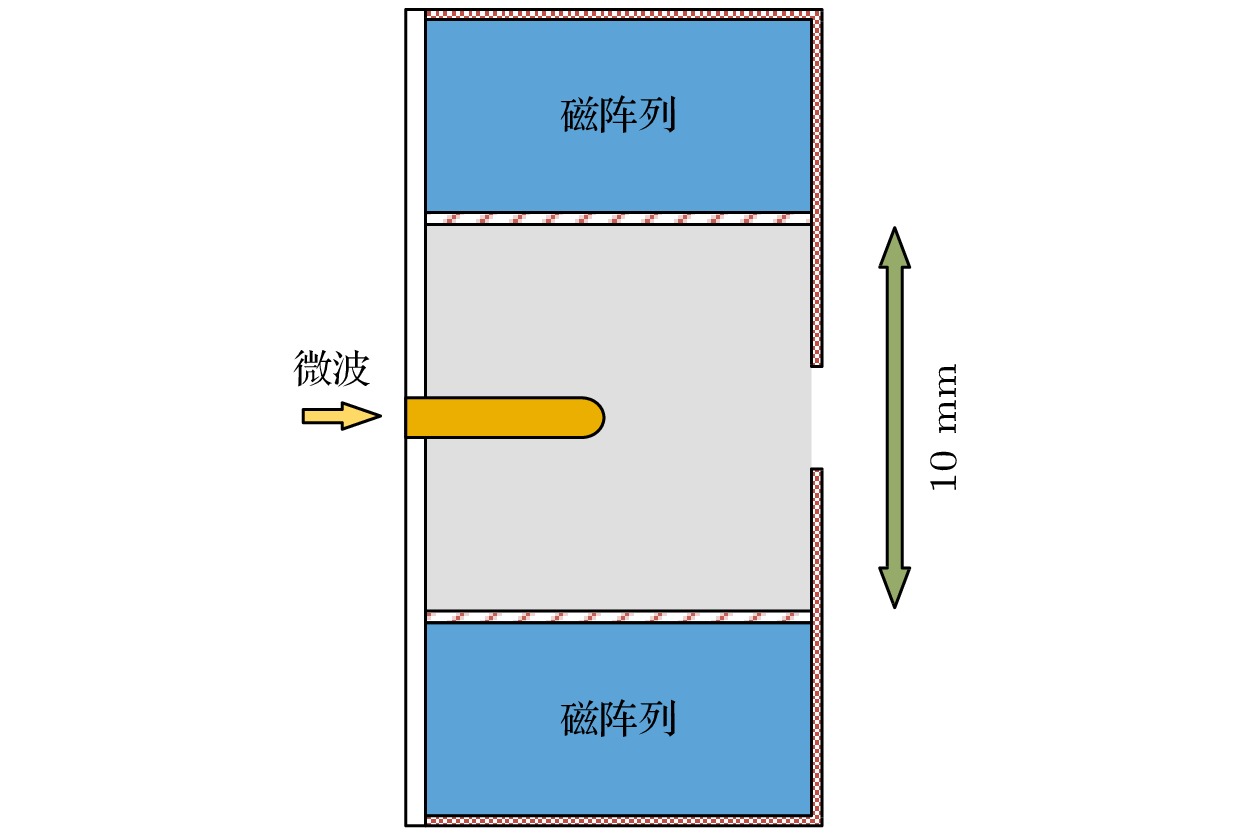
 下载:
下载:
